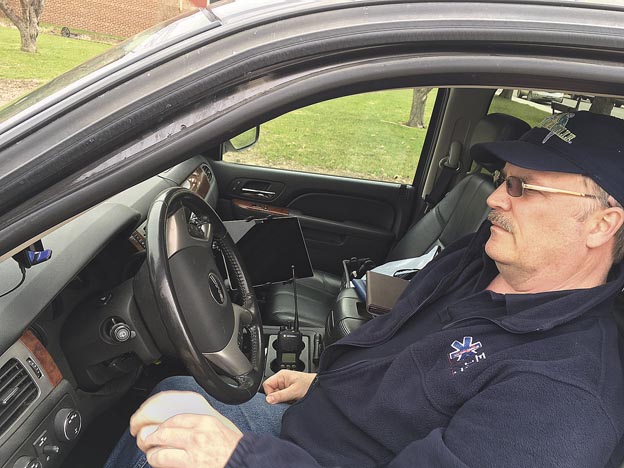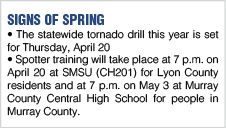


By Per Peterson
Sixty years ago at about this time of the month, 21-year-old Tracy farmer Robert Maeyaert was killed instantly by a bolt of lightning during an afternoon thunderstorm.
Yes, the severe weather season is upon us.
Local severe weather guru Kevin Haney wants everyone to be reminded of that as Severe Weather Awareness Week nears (April 17-21). And if you think you can wait until May or June to start worrying about tornadoes, think again, he said.
“We had three tornadoes in March (this year), which is a first,” Haney said, referring to March 6, when a trio of tornadoes were confirmed in Minnesota. “St. Peter is another example, back in ’98, where it devastated St. Peter, and that was March.”
In other words, tornadoes don’t go by the calendar. They can occur as early as March and as late as September. And for that matter, severe weather isn’t just about funnel clouds and twisters.
“You could get hurt by lighting, by hail, by high winds,” Haney said. “The biggest thing is to be alert of the weather during severe weather season. Respect the weather.”
This year marks the 25th anniversary of the only F5 tornado in the United States to touch down in the United States in 1992. The Chandler-Lake Wilson tornado killed one, injured more than 40. It’s another reminder that people should, as Haney said, respect nature and plan ahead. A summer day can start out sunny and by mid-afternoon, certain areas can be under a tornado warning. Planning ahead and keeping an eye on the forecast can be the different between life and death.
“Look at the forecast, find out what the weather is supposed to be for that day,” he said. “Is it expected to be severe weather? The National Weather Service does a fairly good job of alerting people of severe weather. They will put out a forecast days ahead, so the warnings are out there, it’s a matter of, ‘Did I look at the forecast?’
Haney also said people need to know where their shelters are during outdoor activities. And there is more to be worried about than your a tornado that pops up out of nowhere. He said lightning strikes also need to be respected.
“You could have sunshine, and 10 miles away there’s a thunderstorm and you could still get hit by lighting in,” he said. “You don’t have to be near a thunderstorm to get hit. I talked with a guy that survived a lighting strike ,and it’s amazing — his nerves were fried, but he survived.”
Haney said the severe weather season officially starts in February in the southern states. For Minnesota, it kicks in during June. But, he said, in reality, serve weather season is already here. The region got a reminder of that in 2012 when the area was under a tornado warning and blizzard warning within 24 hours of each other.
“It was a very high precipitation cold front,” he said. “Weather can change very fast and it can be unpredictable — that’s the real scary part. We haven’t harnessed Mother Nature yet. As good as our technology is, it’s an unknown. Weather forecasting is getting better as technology has improved.”
Haney encourages everyone to invest in a Weather Alert radio. He said some people might consider them annoying because they’re always on, “I’d rather have that pain in the neck than get hit by a tornado and not know it. Then you’re dead. It’s one of those alerting mechanisms — it costs 30 bucks or less, and one day it could save your life.”
He said the radios are backed up by batteries and you can take them anywhere in the country.
For more on this article, see this week’s Headlight-Herald.
